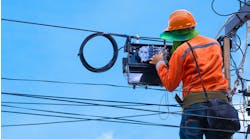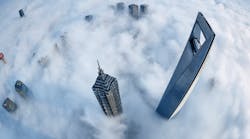How Much Is It Costing Your Company?
What would you do if a pollutant in your office was killing $5,000 of profit this year?
What would you do if every single employee spewed forth that much pollution each year?
This pollutant, called Ineffective Communication, affects every employee, and causes smog in your organization that prevents clear and concise communication — while killing profits.
While most executives believe that communication is important, very few have ever tried to quantify their losses.
Communication Smog causes an average loss of 40 minutes of productive time for every employee, every day, of every year; and that is just Category 1 Smog.
As the pollutant builds and thickens, it can cause your organization significant damage.
Category 1 Communication Smog
If your company is like most, you operate in a continual state of Category 1 Communication Smog, and the typical employee will lose 167 hours of productive time per year.
At the 2015 average US salary, benefits and tax levels, that equates to $5,200 per employee per year.
Most people don’t realize the amount of time lost daily due to issues like:
• Seeking clarification
• Asking a question multiple times
• Resolving customer or employee conflicts
• Never-ending email threads
• Crisis management due to missed deadlines
• Re-work
The reason companies often don’t recognize the importance of these issues is that with Category 1 Smog, the impact of each issue is too small to be noticed as a financial impact.
While this pollutant could be considered insignificant at the individual issue level, over the course of a year, a company with 20 employees is likely to lose over $100,000 of productive time.
At this level all it takes is a good breeze of education and coaching to clear the air, regain that productive time, and prevent further pollution.
Category 2 Communication Smog
As ineffective communication pollution continues to be added to your environment, the Smog thickens, covering more of your organization. The impact increases, and now becomes visible on your financial statements.
In addition to all of the Category 1 impacts, you start experiencing:
• Lost sales and customers
• Increased marketing, customer acquisition and customer service costs
• Increased staff turnover, hiring and training costs
• Decreased operational continuity
In Category 2 Communication Smog, the following symptoms appear regularly:
• Sarcastic and negative comments emitted towards customers, employees, and management
• Employees resistant to raising issues in any forum
• All levels of staff operate in a CYA (“cover your assets”) mode
• Lack of faith in the team and the organization
When you have Category 1 Smog, a good breeze of education and coaching will clear the air — but when you reach Category 2, you are going to need gale force winds.
At this level of dysfunction, Category 2, the cost, time, resources, and organization discomfort required to correct the issue is exponentially greater than Category 1.
Category 3 Communication Smog
Left unattended, Communication Smog will continue to build, and the Communication Smog surrounding your team will become so thick that serious financial impacts will be felt.
When communication problems are allowed to evolve to Category 3, the smog becomes so thick that issues escalate and have a high financial impact. You will observe:
• Prevalent sarcasm and negativity
• Inappropriate comments about customers and management
• Conflicting objectives within management
• A complete breakdown of trust and communication
• High employee turnover
• Legal costs skyrocketing due to escalating issues
• Large-scale customer defections
• Loss of reputation
Picture the air in a post-apocalyptic Sci-Fi movie: that grey, murky sky with people scurrying around in the shadows. That is the environment in your company when you reach Category 3 Communication Smog.
The Category 3 Communication Smog is going to require hurricane force winds to clear the air.
Success will be difficult without significant management changes and a wholesale cultural change.
Don’t think it could happen to you?
Ineffective communication is a slippery slope that left unattended can grow silently, until one day you are losing valued customers.
When surveying business owners and executives, concern is warranted as they report that:
• Communication skills are a critical part of their long term success
• Virtually none measure the impact of ineffective communication
• Very few have a comprehensive plan to develop this critical skill
How can something that has this big of an impact on business get so little attention?
The Fix: Clearing the AIR
Whether you are like most companies and facing a Category 1 Communication Smog or a larger threat to your business, there comes a time where your success will require you to get rid of the smog and clear the air allowing clean and concise communication to work its magic.
To clear the AIR, simply remember: Acknowledgement, Identification, and Remediation.
Acknowledgement
The first and often hardest step in clearing the air is the acknowledgement of the problem, and that it impacts EVERYONE in the organization.
In order for any plan to be successful, ALL levels of management must agree that communication is important and that everyone has room to improve. Once there is true acknowledgement that Communication needs to be addressed, you can move to the next step.
Identification
In order to maximize the results from any remediation plan, it is critical that the highest impact communication problems be addressed first. To properly assign priority, an assessment should be done that evaluates communication based on:
• Job title/position
• Duration of service with the company
• General categories of communication
• Common communication issues
Based on the assessment, you can now begin developing a remediation plan that will get you maximum gain quickly and start clearing the air.
Remediation
Your remediation plan should focus on the processes and skills required to create an environment for clear and concise communications.
By launching initial elements of the remediation plan on high target areas, you are able to quickly gain the momentum and create a ripple effect that will be required to flush the pollution and the smog from your environment.
A common sequence of learning priorities is:
• Establishing a habit of having a clear intention when communicating
• Using the "You Focused" presenting (maintaining a focus on the needs of the other to ensure clear communication)
• Developing and delivering messages with clarity
• Enhancing your message with improved presentation skills
• Learning how to formulate and ask powerful questions
Take an intentional approach to communication skills throughout your organization, and you will create a clean air environment where communication flows freely and effectively.
You have accounting professionals making sure your money and finances are taken care of and legal professionals keeping you out of trouble. Make sure you have a professional on your team making sure you are not falling victim to Communication Smog.
About the Author
Mark A. Vickers is a Certified Professional Coach, and Certified World Class Speaking Coach. Mark is a communications consultant focused on helping you and your organization improve performance through improved communication and speaking skills. He is known as a creative author and speaker, and for creating the Communications Challenge, an objective way to measure communication effectiveness. For more information, please visit: http://speakingisselling.com/.




